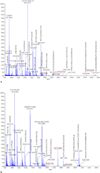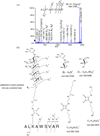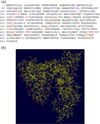Determination of the glycation sites of Bacillus anthracis neoglycoconjugate vaccine by MALDI-TOF/TOF-CID-MS/MS and LC-ESI-QqTOF-tandem mass spectrometry
- PMID: 22012665
- PMCID: PMC3427925
- DOI: 10.1002/jms.1980
Determination of the glycation sites of Bacillus anthracis neoglycoconjugate vaccine by MALDI-TOF/TOF-CID-MS/MS and LC-ESI-QqTOF-tandem mass spectrometry
Abstract
We present herein an efficient mass spectrometric method for the localization of the glycation sites of a model neoglycoconjugate vaccine formed by a construct of the tetrasaccharide side chain of the Bacillus anthracis exosporium and the protein carrier bovine serum albumin. The glycoconjugate was digested with both trypsin and GluC V8 endoproteinases, and the digests were then analyzed by MALDI-TOF/TOF-CID-MS/MS and nano-LC-ESI-QqTOF-CID-MS/MS. The sequences of the unknown peptides analyzed by MALDI-TOF/TOF-CID-MS/MS, following digestion with the GluC V8 endoproteinase, allowed us to recognize three glycopeptides whose glycation occupancies were, respectively, on Lys 235, Lys 420, and Lys 498. Similarly, the same analysis was performed on the tryptic digests, which permitted us to recognize two glycation sites on Lys 100 and Lys 374. In addition, we have also used LC-ESI-QqTOF-CID-MS/MS analysis for the identification of the tryptic digests. However, this analysis identified a higher number of glycopeptides than would be expected from a glycoconjugate composed of a carbohydrate-protein ratio of 5.4:1, which would have resulted in glycation occupancies of 18 specific sites. This discrepancy was due to the large number of glycoforms formed during the synthetic carbohydrate-spacer-carrier protein conjugation. Likewise, the LC-ESI-QqTOF-MS/MS analysis of the GluC V8 digest also identified 17 different glycation sites on the synthetic glycoconjugate.
Copyright © 2011 John Wiley & Sons, Ltd.
Figures






Similar articles
-
Determination of glycation sites by tandem mass spectrometry in a synthetic lactose-bovine serum albumin conjugate, a vaccine model prepared by dialkyl squarate chemistry.Rapid Commun Mass Spectrom. 2012 Apr 15;26(7):749-58. doi: 10.1002/rcm.6166. Rapid Commun Mass Spectrom. 2012. PMID: 22368054 Free PMC article.
-
Mapping the glycation sites in the neoglycoconjugate from hexasaccharide antigen of Vibrio cholerae, serotype Ogawa and the recombinant tetanus toxin C-fragment carrier.J Mass Spectrom. 2013 Oct;48(10):1083-90. doi: 10.1002/jms.3258. J Mass Spectrom. 2013. PMID: 24130011 Free PMC article.
-
Revealing the glycation sites in synthetic neoglycoconjugates formed by conjugation of the antigenic monosaccharide hapten of Vibrio cholerae O1, serotype Ogawa with the BSA protein carrier using LC-ESI-QqTOF-MS/MS.J Mass Spectrom. 2012 Jul;47(7):890-900. doi: 10.1002/jms.2974. J Mass Spectrom. 2012. PMID: 22791257 Free PMC article.
-
Quantitative mass spectrometry for bacterial protein toxins--a sensitive, specific, high-throughput tool for detection and diagnosis.Molecules. 2011 Mar 14;16(3):2391-413. doi: 10.3390/molecules16032391. Molecules. 2011. PMID: 21403598 Free PMC article. Review.
-
Methods in enzymology: O-glycosylation of proteins.Methods Enzymol. 2005;405:139-71. doi: 10.1016/S0076-6879(05)05007-X. Methods Enzymol. 2005. PMID: 16413314 Review.
Cited by
-
Determination of glycation sites by tandem mass spectrometry in a synthetic lactose-bovine serum albumin conjugate, a vaccine model prepared by dialkyl squarate chemistry.Rapid Commun Mass Spectrom. 2012 Apr 15;26(7):749-58. doi: 10.1002/rcm.6166. Rapid Commun Mass Spectrom. 2012. PMID: 22368054 Free PMC article.
-
Electron-Transfer/Higher-Energy Collision Dissociation (EThcD)-Enabled Intact Glycopeptide/Glycoproteome Characterization.J Am Soc Mass Spectrom. 2017 Sep;28(9):1751-1764. doi: 10.1007/s13361-017-1701-4. Epub 2017 Jul 10. J Am Soc Mass Spectrom. 2017. PMID: 28695533 Free PMC article.
-
Mapping the glycation sites in the neoglycoconjugate from hexasaccharide antigen of Vibrio cholerae, serotype Ogawa and the recombinant tetanus toxin C-fragment carrier.J Mass Spectrom. 2013 Oct;48(10):1083-90. doi: 10.1002/jms.3258. J Mass Spectrom. 2013. PMID: 24130011 Free PMC article.
-
Revealing the glycation sites in synthetic neoglycoconjugates formed by conjugation of the antigenic monosaccharide hapten of Vibrio cholerae O1, serotype Ogawa with the BSA protein carrier using LC-ESI-QqTOF-MS/MS.J Mass Spectrom. 2012 Jul;47(7):890-900. doi: 10.1002/jms.2974. J Mass Spectrom. 2012. PMID: 22791257 Free PMC article.
References
-
- Weintraub A. Immunology of bacterial polysaccharide antigens. Carbohydr. Res. 2003;338:2539. - PubMed
-
- Rietschel ET, Wollenweber HW, Brade H, Zahring U, Linder B, Seydel U, Bradaezek H, Barnickel G, Labischinski H, Giesbrecht P. In: Handbook of Endotoxins, Chemistry of Endotoxins. Rietschel ET, editor. Amsterdam, The Netherlands: Elsevier; 1984. p. 187.
-
- Holst O, Brade H. Molecular Biochemistry and Cellular Biology. In: Morrison DC, Ryan JL, editors. Bacterial Endotoxic Lipopolysaccharides. CRC Press: Boca Raton, Florida, USA; 1992. p. 135.
-
- Raetz CRH. Biochemistry of Endotoxins. Ann. Rev. Biochem. 1990;59:129. - PubMed
-
- Kubler-Kielb J, Vinogradov E, Ben-Menachem G, Pozsgay V, Robbins JB, Schneerson R. Saccharide/protein conjugate vaccines for Bordetella species: Preparation of saccharide, development of new conjugation procedures, and physico-chemical and immunological characterization of the conjugates. Vaccin. 2008;26:3587. - PMC - PubMed
MeSH terms
Substances
Grants and funding
LinkOut - more resources
Full Text Sources
Medical

